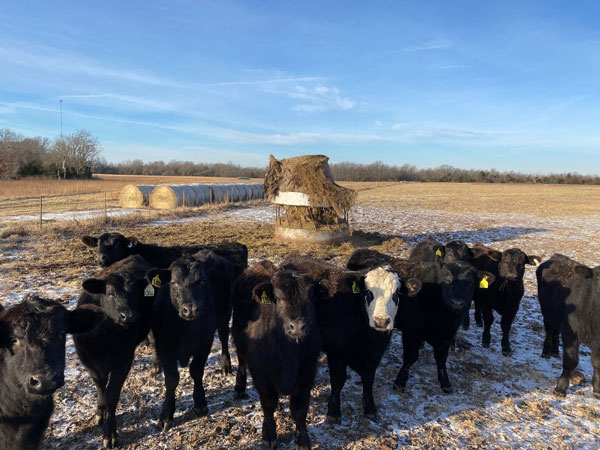Hay is the most important fiber source for cattle during the winter in Kansas. As the temperatures drop and the forage growth rate slows down, we need to figure out if the stored hay on the farm is enough to feed the animals during the winter (Figure 1). Calculating the amount of hay needed is the first step to successfully keeping the animals growing. However, buying hay is crucial if the hay stocked is not enough.

Figure 1. Animals being hay fed during the winter. Photo by Bruno C. Pedreira, K-State Research and Extension.
Important considerations when buying hay
Average weight. It is very common to buy hay by the bale. However, each bale of hay has a different weight. Depending on the baler settings and the forage moisture during harvest, the bale can have a higher or lower density, which will directly affect weight. It would be great to know the average weight of the bales before buying them. A better option would be to buy hay by tonnage.
Nutritive value. Some sellers will have a lab analysis report of the hay’s chemical composition (moisture, crude protein, and energy). Based on that, it is possible to calculate the feed value per ton of forage. If a bale has 5 or 8% crude protein, the amount the protein needed to supplement the animal will be different, because the nutritional requirements need to be matched. The differences in nutritive value will affect the cattle feed cost and need to be considered before buying the hay. In years of severe drought, nutritive analysis of hays become especially important for cattle feeding and supplementation perspective.
Storage conditions. If the bales were harvested this year, storage is not a big issue, but if it has been harvested one or two years ago, you need to consider how it has been stored. Bales stored in a barn are much less subject to bad weather and, consequently, fewer losses. If the bales are in the field, favor bales stacked in pallets above those on the ground (Figure 2).
Type of hay and where you are feeding. One thing that is often overlooked in drought years when farmers are looking for anything to feed is what undesirable plant species you may be introducing into your operation. If you plan on feeding the hay while cattle are still on pasture, there is good chance for any “weed” species to be spread around your operation. Weeds are any undesirable plants growing in the location. Such as, if you happen to have warm-season pastures and do not want to introduce a cool-season perennial, then make sure purchased hay contains little to none of the undesirable plants.

Figure 2. Hay bales in the field. Photo by Bruno C. Pedreira, K-State Research and Extension.
This was a very dry year where most hayfields did not produce the expected yield. Additionally, hay prices have been higher than normal. Therefore, hay has been harvested everywhere and in different conditions. In years such as 2022, buying hay has been even harder so it is very important to know what are you buying in order to pay the appropriate price.
Bruno Pedreira, Southeast Area Agronomist - Parsons
pedreira@ksu.edu
Jaymelynn Farney, Southeast Area Beef Specialist - Parsons
jkj@ksu.edu